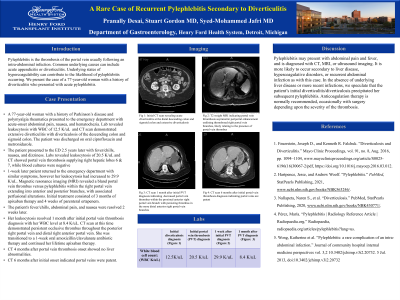Monday Poster Session
Category: Liver
P2528 - A Rare Case of Recurrent Pylephlebitis Secondary to Diverticulitis
Monday, October 23, 2023
10:30 AM - 4:15 PM PT
Location: Exhibit Hall

Has Audio

Pranally A. Desai
Henry Ford Hospital, MI
Presenting Author(s)
Pranally A. Desai, 1, Stuart Gordon, MD1, Syed-Mohammed Jafri, MD2
1Henry Ford Hospital, Detroit, MI; 2Henry Ford Health System, Detroit, MI
Introduction: Pylephlebitis is the thrombosis of the portal vein usually following an intra-abdominal infection. We present a patient with a history of diverticulitis who presented with acute pylephlebitis.
Case Description/Methods: A 77-year-old female with a history of Parkinson’s disease and polymyalgia rheumatica presented to the emergency department (ED) with acute-onset abdominal pain, nausea, and hematochezia with leukocytosis (WBC, 12.5 K/uL). Computed tomography scan (CT) showed diverticulitis of the distal descending colon and sigmoid colon, with extensive diverticulosis. She was discharged on oral ciprofloxacin and metronidazole.
She returned to the ED 2.5 years later with dizziness, fever/chills, and nausea. Labs revealed WBC of 20.5 K/uL. CT showed portal vein thrombosis (PVT) supplying the right hepatic lobe segments 6 and 7. Blood cultures were negative and she was discharged, but one week later, she returned to the ED with continued fever/chills, negative blood cultures, and WBC was now 29.9 K/uL. Magnetic resonance imaging (MRI) revealed a bland portal vein thrombus versus pylephlebitis within the right portal vein extending into anterior and posterior branches, with associated perfusional alterations. Treatment consisted of 3 months of apixaban therapy and 4 weeks of parenteral ertapenem.
A CT scan 1 month after her most recent ED visit showed persistent occlusive thrombus throughout the posterior right portal vein and distal right anterior portal vein. Patient was transitioned to a 1-week oral amoxicillin/clavulanate antibiotic therapy and continued her lifetime apixaban therapy. The patient’s symptoms of fever/chills, abdominal pain, and nausea were resolved 2 weeks after initial PVT diagnosis, with leukocytosis resolving 1 month after initial diagnosis (WBC 8.4 K/uL). CT 4 months after PVT onset showed no liver abnormalities, and CT 6 months after onset indicated portal veins were patent.
Discussion: Pylephlebitis may present with abdominal pain and fever, and is diagnosed with CT, MRI, or ultrasound imaging. It is more likely to occur secondary to liver disease, hypercoagulative disorders, or recurrent abdominal infection as with this case. In the absence of underlying liver disease or more recent infections, we speculate that the patient’s initial diverticulitis/diverticulosis precipitated her subsequent pylephlebitis. Anticoagulation therapy is normally recommended, occasionally with surgery depending upon the severity of the thrombosis.
Disclosures:
Pranally A. Desai, 1, Stuart Gordon, MD1, Syed-Mohammed Jafri, MD2. P2528 - A Rare Case of Recurrent Pylephlebitis Secondary to Diverticulitis, ACG 2023 Annual Scientific Meeting Abstracts. Vancouver, BC, Canada: American College of Gastroenterology.
1Henry Ford Hospital, Detroit, MI; 2Henry Ford Health System, Detroit, MI
Introduction: Pylephlebitis is the thrombosis of the portal vein usually following an intra-abdominal infection. We present a patient with a history of diverticulitis who presented with acute pylephlebitis.
Case Description/Methods: A 77-year-old female with a history of Parkinson’s disease and polymyalgia rheumatica presented to the emergency department (ED) with acute-onset abdominal pain, nausea, and hematochezia with leukocytosis (WBC, 12.5 K/uL). Computed tomography scan (CT) showed diverticulitis of the distal descending colon and sigmoid colon, with extensive diverticulosis. She was discharged on oral ciprofloxacin and metronidazole.
She returned to the ED 2.5 years later with dizziness, fever/chills, and nausea. Labs revealed WBC of 20.5 K/uL. CT showed portal vein thrombosis (PVT) supplying the right hepatic lobe segments 6 and 7. Blood cultures were negative and she was discharged, but one week later, she returned to the ED with continued fever/chills, negative blood cultures, and WBC was now 29.9 K/uL. Magnetic resonance imaging (MRI) revealed a bland portal vein thrombus versus pylephlebitis within the right portal vein extending into anterior and posterior branches, with associated perfusional alterations. Treatment consisted of 3 months of apixaban therapy and 4 weeks of parenteral ertapenem.
A CT scan 1 month after her most recent ED visit showed persistent occlusive thrombus throughout the posterior right portal vein and distal right anterior portal vein. Patient was transitioned to a 1-week oral amoxicillin/clavulanate antibiotic therapy and continued her lifetime apixaban therapy. The patient’s symptoms of fever/chills, abdominal pain, and nausea were resolved 2 weeks after initial PVT diagnosis, with leukocytosis resolving 1 month after initial diagnosis (WBC 8.4 K/uL). CT 4 months after PVT onset showed no liver abnormalities, and CT 6 months after onset indicated portal veins were patent.
Discussion: Pylephlebitis may present with abdominal pain and fever, and is diagnosed with CT, MRI, or ultrasound imaging. It is more likely to occur secondary to liver disease, hypercoagulative disorders, or recurrent abdominal infection as with this case. In the absence of underlying liver disease or more recent infections, we speculate that the patient’s initial diverticulitis/diverticulosis precipitated her subsequent pylephlebitis. Anticoagulation therapy is normally recommended, occasionally with surgery depending upon the severity of the thrombosis.
Disclosures:
Pranally Desai indicated no relevant financial relationships.
Stuart Gordon indicated no relevant financial relationships.
Syed-Mohammed Jafri: Gilead, Takeda, Abbvie – Advisor or Review Panel Member, Speakers Bureau.
Pranally A. Desai, 1, Stuart Gordon, MD1, Syed-Mohammed Jafri, MD2. P2528 - A Rare Case of Recurrent Pylephlebitis Secondary to Diverticulitis, ACG 2023 Annual Scientific Meeting Abstracts. Vancouver, BC, Canada: American College of Gastroenterology.
